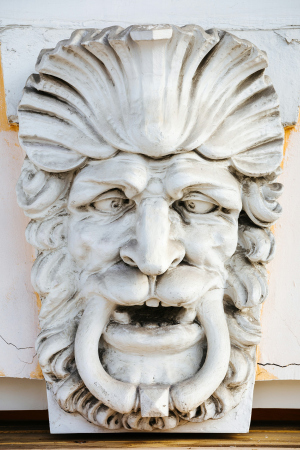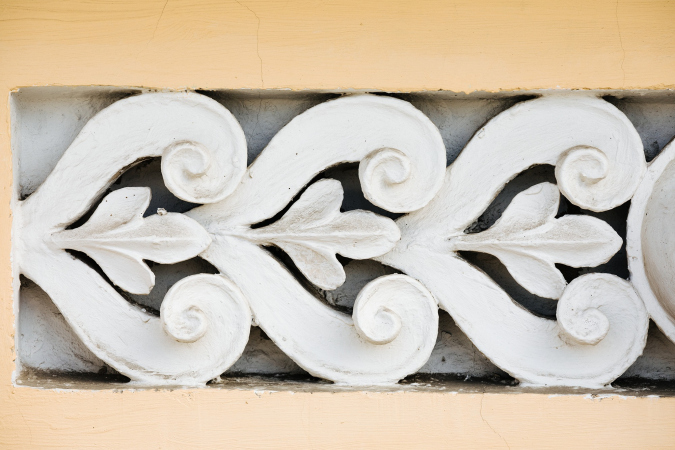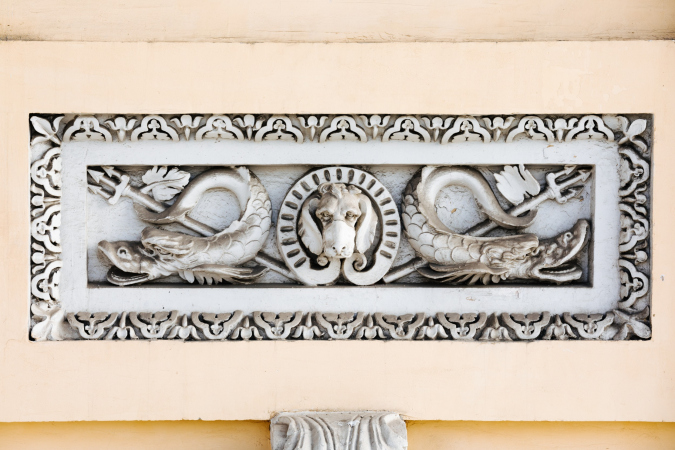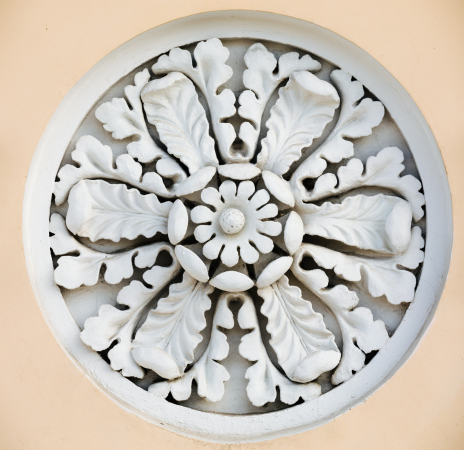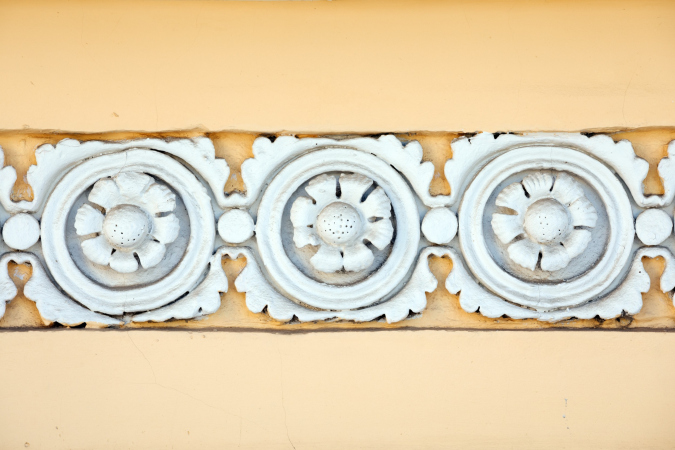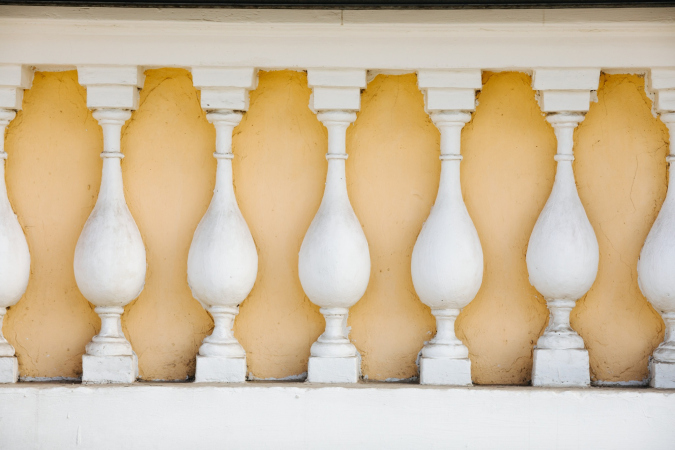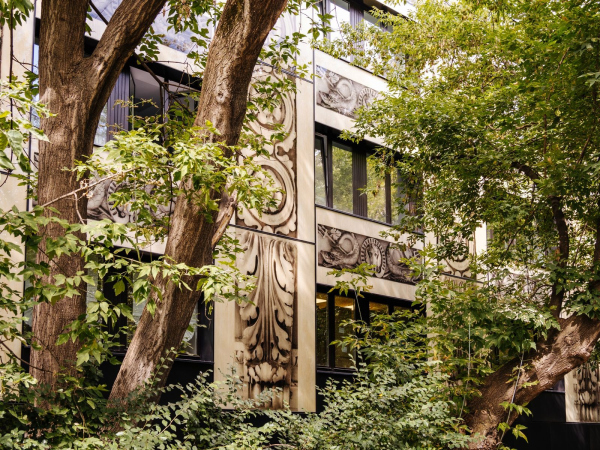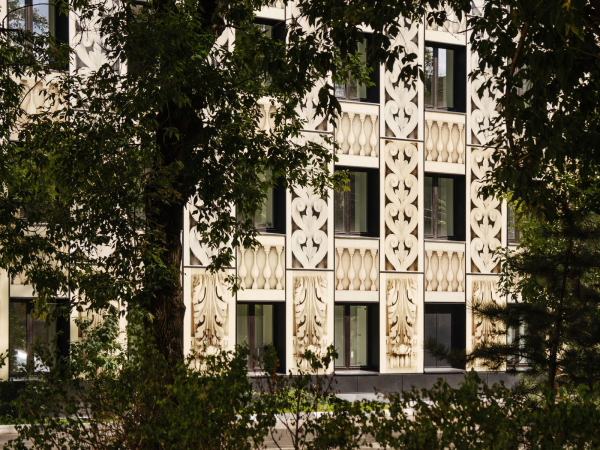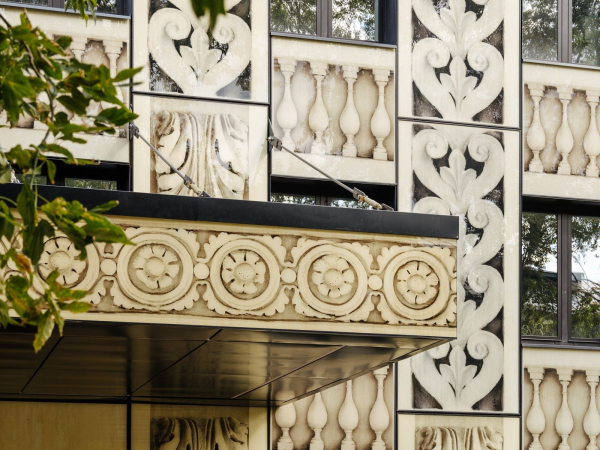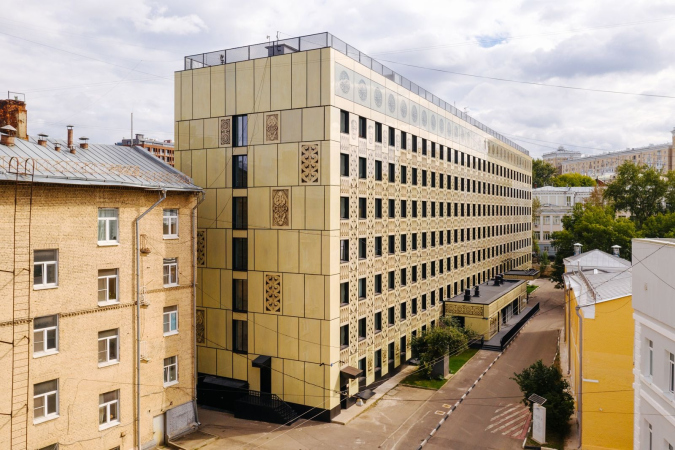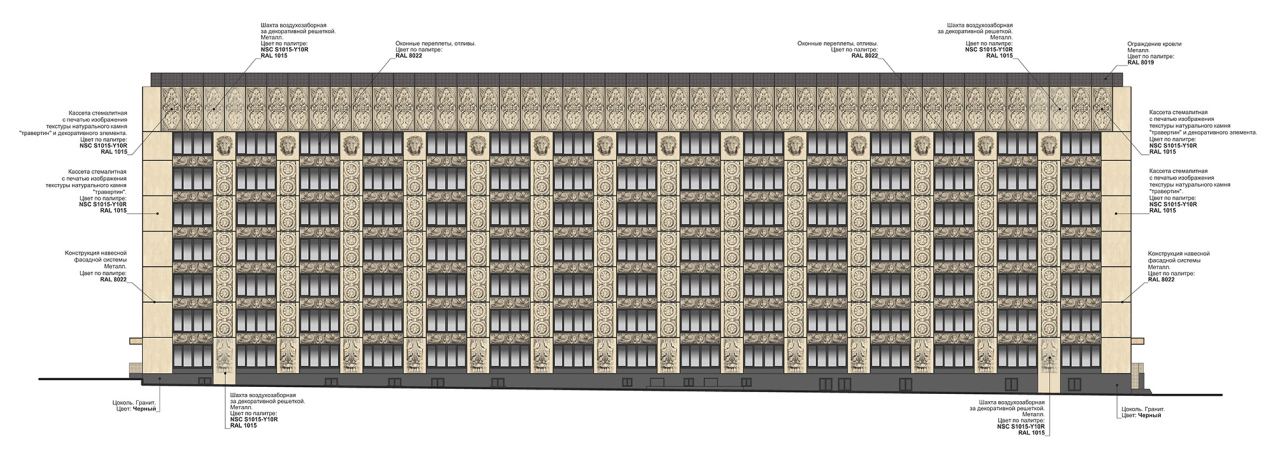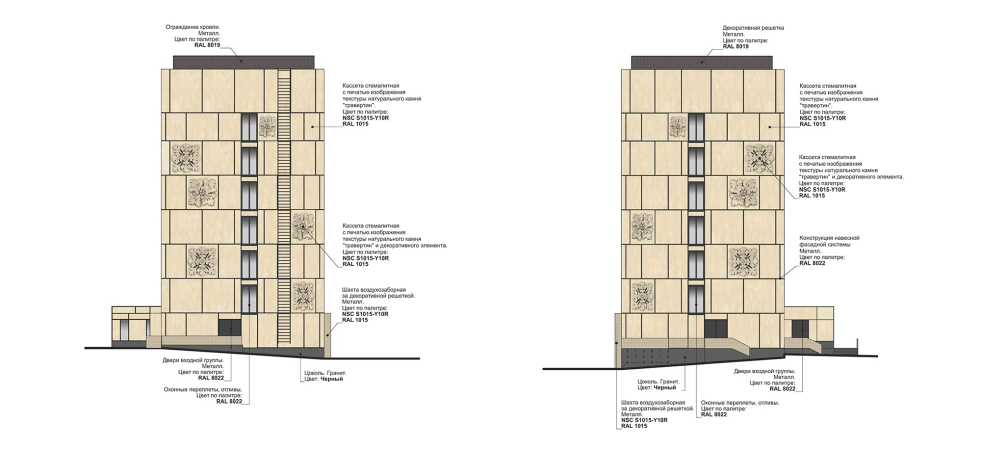The restored wing of the Batashev manor house, a fragment
Copyright: Photograph © Archi.ru
The palace is well preserved, even though it survived the fire of 1812. In the 1870’s, the Batashev estate was sold to the city and was reconstructed as the Yauza Hospital; in the early XX century, it got a few new buildings in the neo-empire style of the Silver Age, one of them authored by Illarion Ivanov-Shiz. In the Soviet time, the hospital was renamed into “Medsantrud”; in the 1920’s it belonged to “State Political Directorate”, and then to various medical institutes. Today, the hospital is named after one of the professors who worked in it in the 1930’s, Ippolit Vasilyevich Davydkovsky, a pathologist; during the Great Patriotic War he was the organizer of the field surgery system.
In other words, this hospital, which specializes in surgery and neurology, is more than well-known, and the palace itself is a popular example of Moscow classicism. Its restoration began in 2019 together with the integrated reconstruction of the hospital, the Building #4 in question being a part of the reconstruction project. The six-story building was constructed in 1972 according to the standard design of the 2MG-05-5 series, on the eastern border of the hospital territory, along the Zemlyansky Lane. A laconic white panel building, a functional structure on the former palace grounds.
Building 4 before the reconstruction. The city clinic #23 named after Ippolit Davydovsky
Copyright: Photograph © SPEECH
Building 4 before the reconstruction. The city clinic #23 named after Ippolit Davydovsky
Copyright: Photograph © SPEECH
In Moscow, reconstruction of such buildings usually consists, in addition to engineering and interior work, in the insulation of facades, which are covered, over mineral wool, with plaster, porcelain stoneware or, at best, with aluminum cassettes.
However, the SPEECH architects came up with a more sophisticated proposal, which responds to the proximity of the famous palace. As part of this charity project, they developed a project of façade reconstruction, based on the idea implemented by Sergey Tchoban 10 or 15 years ago in Saint Petersburg’s business centers “LangenZipen”, “Benoit”, and “Vremena Goda” – glass cassettes with photographs of historical decoration, applied to the inner side of the cassette.
The city clinic #23 named after Ippolit Davydovsky. Reconstruction of Building 4
Copyright: Photograph © Dmitry Chistoprudov
The main entrance to Building 4 is situated on the inner side from the territory of the hospital. On either side of the entrance group, accessed by a gently sloping ramp, the authors placed two unique prints – enlarged photographs of the reliefs from the main staircase of the Batashev palace, redecorated after the fire of 1812 under the supervision of Domenico Gilardi: “Farewell to the Warrior” and “The Return of Odysseus”.
Farewell to the Warrior (a possible alternative interpretation is the sign of Aeneas to leave Troy. See the thesis by SM Tsareva). The relief of the main staircase of the house of Ivan Batashev. The city clinic #23 named after Ippolit Davydovsky
Copyright: Photograph © Dmitry Chistoprudov
Return of Odysseus. The relief of the main staircase of the house of Ivan Batashev. The city clinic #23 named after Ippolit Davydovsky
Copyright: Photograph © Dmitry Chistoprudov
These reliefs were created a little bit later than the façade décor of the main house, as they refer to the empire-style of the post-fire period. Specifically because of that, the modeling, slender and full of details, including faces and costumes, easily withstood the enlargement. The genuine reliefs on the staircase are smaller in size, are farther away from the viewer, and are meant to be viewed from below. In the printed pattern, these are enlarged, even though they stay slightly less than human height and are moved to the foreground as much as possible: whoever will walk past them on the way to the entrance, will be able to examine the details, and even compare themselves to these figures scale-wise.
What is curious is the illusion of volume: the contrasting chiaroscuro of the photographs emphasizes the relief, and at some point it seems that the figures are only placed under glass, as in a museum showcase; but on the other hand, they are drawn on glass, and look a little like a hologram.
The city clinic #23 named after Ippolit Davydovsky. Reconstruction of Building 4
Copyright: Photograph © Dmitry Chistoprudov
The city clinic #23 named after Ippolit Davydovsky. Reconstruction of Building 4
Copyright: Photograph © Archi.ru
All the other reliefs, represented on the glass panels, belong to the outside decoration of the palace, evidently executed by the boarder of the Academy of Fine Arts, Mikhail Kiselnikov, still in the pre-fire period. Historians note the originality of these details, probably inspired by the Italian experience of this serf artist. Indeed, the facial expressions of the mascarons are completely atypical and may resemble the grimace in the Santa Maria Formosa bell tower in Venice; no less interesting are the compositions with tritons, tridents and a “dog” in the center – from the molded decorations of the main facade of the Batashev palace.
Plus the rosettes, decorative balustrades, and cantilevered structures with a rich leafy ornament. All of these elements became the basis for the décor, applied to the glass panels, and they all are dramatically increased in their scale, largely losing their places in the logic of a classicist façade, at the same time getting a new meaning.
The city clinic #23 named after Ippolit Davydovsky. Reconstruction of Building 4
Copyright: Photograph © Dmitry Chistoprudov
The overall logic of placing these elements is also decorative, akin to a carpet. But then again, it has a classical basis as well: the white parallelepiped with windows got verticals and horizontals, top and bottom, an attic with rosettes, and a basement tier with cantilevers. The horizontals of the balustrades cut through the verticals of the “pilasters” across their entire height; they start from the cantilevers, and end in the “lion” column caps. The dolphins that are depicted on the main façade of the palace, which overlooks the lane, are now represented on the street façade of the building.
The pitch of enlargement also varies: the miniature rosettes, placed in the original relief underneath the windows, and a fragment of the wavy pattern, are enlarged significantly, rolled over in respect to their basic horizontal position, and serve to decorate the “pilasters”. However, there is no deliberate “juggling” with the elements and fragments – rather, the motifs, justified by the proximity of the classicist palace, form some new large pattern with an inner logic of its own.
The city clinic #23 named after Ippolit Davydovsky. Reconstruction of Building 4
Copyright: Photograph © Dmitry Chistoprudov
This pattern looks like grisailles, drowned in the travertine-imitating golden-and-beige tone, which refers us more to the stone of classical architecture in its common meaning than to the yellow paint of the classicist façades. The new façade is not an attempt to turn the 1972 building into a semblance of a palace wing – rather, it becomes some reminder about the monument of architecture, a giant engraved picture of it being displayed at an exhibition. An attempt to revive the valuable reliefs, bringing them to the attention of a passer-by or a patient. And, of course, an attempt to embellish and fill with emotion the building and its surroundings.
The photographs of the façade reliefs are beautiful as they are, especially zoomed in in a slanted light. The sculptural surface, conceived by the author, in real relief is combined with irregularities, paint drips, and urban grime – these two drawings, conceived and real, are superimposed on each other and in such a combination are endowed with a special appeal. One feels like taking their pictures and examining them. Admiring them. Essentially, this is what the authors of the project of the facades of Building 4 are trying to get us to do – admire the zoomed-in reliefs, just passing by. To be surprised to see a huge cantilever behind the thickets of American maples, either embossed or “painted”, but similar to a part of some park grotto from Italy, where the serf architect Kiselnikov studied architecture.
The glass cassettes have yet another special feature: in addition to the fact that the drawing is elaborate and precise, the glass surface reflects the surroundings. Shadows, reflections of neighboring buildings, the palace wings, the nearby church, and the outlines of the trees are superimposed on the pictures taken out of context and enlarged – a technique that further embellishes and enriches the drawing when it is directly perceived.
The city clinic #23 named after Ippolit Davydovsky. Reconstruction of Building 4
Copyright: Photograph © Archi.ru
The city clinic #23 named after Ippolit Davydovsky. Reconstruction of Building 4
Copyright: Photograph © Archi.ru
Of course, the façade reconstruction is limited in its possibilities, and in this case the glass cassettes only helped to “collect” the volume of the building and immerse it into ornamentation. The windows retained their small sizes and recognizable proportions, even though the chamfers did give them some extra depth.
However, one must keep in mind that essentially the whole project was about insulating the façades – and grew into an interesting experiment of working with reliefs, which, being turned into graphics, retain some of the characteristic traits of sculpture because, when viewed from a certain angle, the illusion of volume suggests itself. On the one hand, the repetition and mass production are obvious; on the other hand, there is no direct copying because these motifs are transferred over to a different material and are interpreted as a part of a different system. Rather, it is a collage with magnification, akin to the approach of a collector who is examining interesting details under a magnifying glass – and inviting the passersby to do the same.













